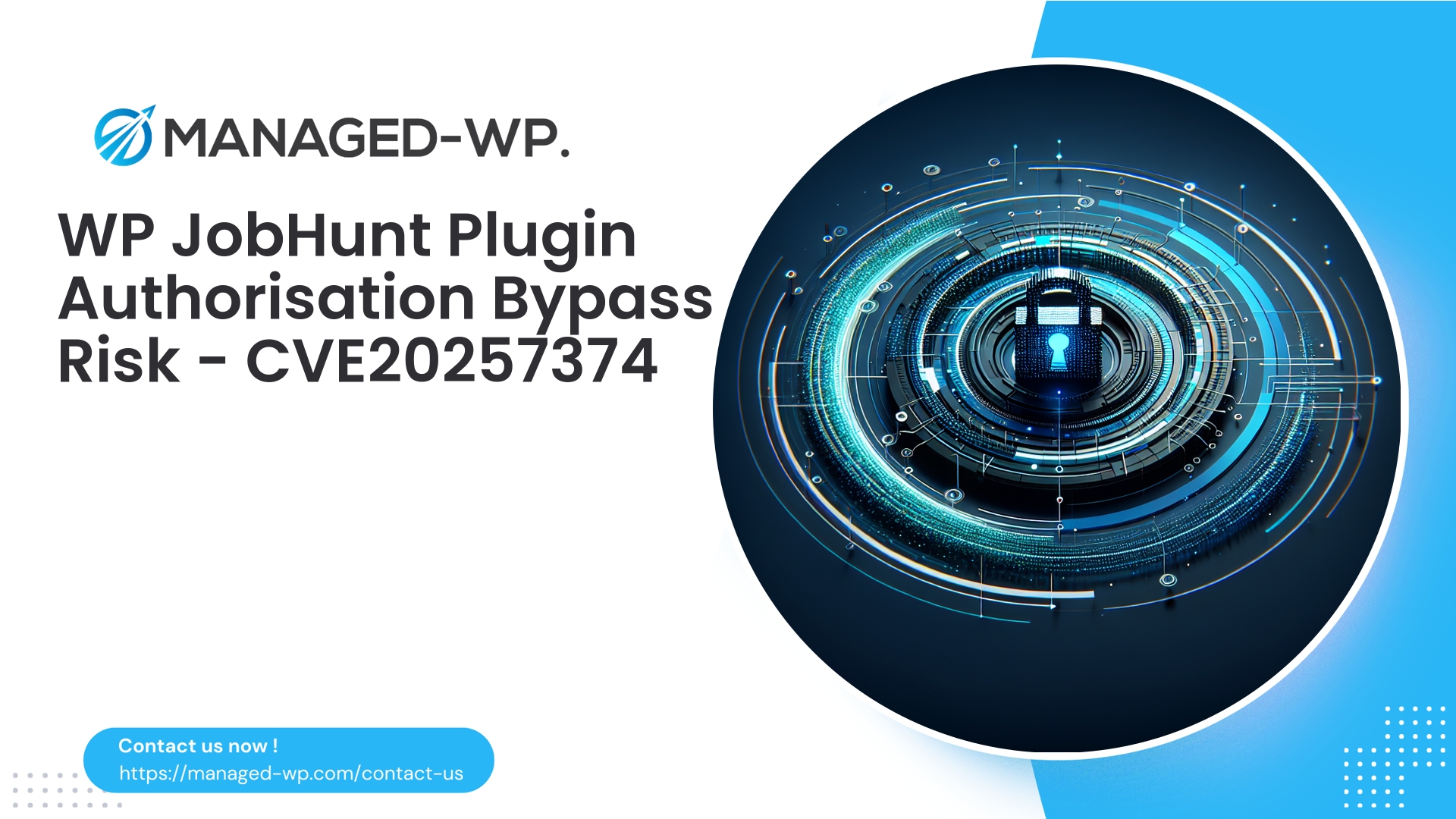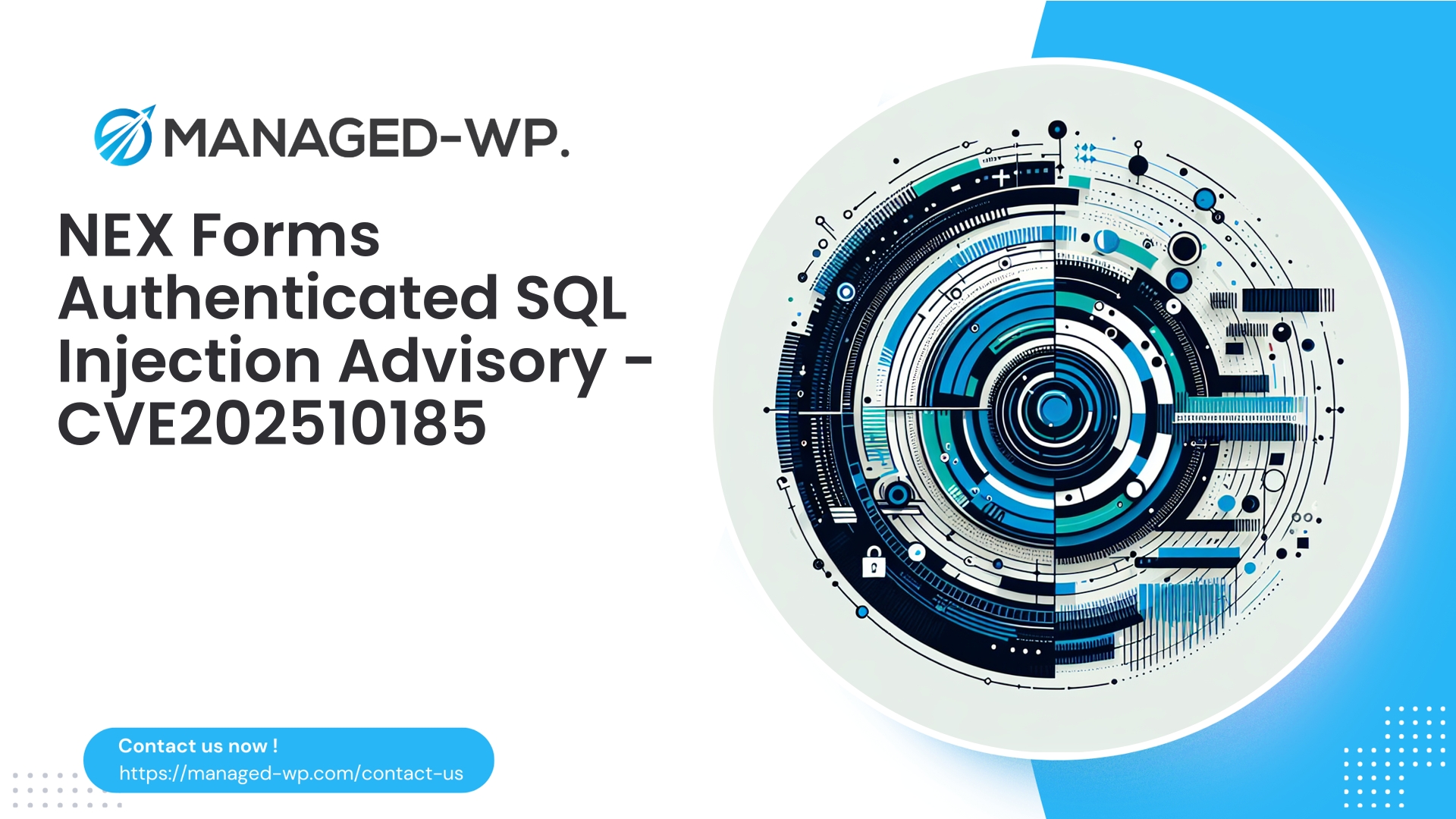| 插件名称 | WP JobHunt |
|---|---|
| 漏洞类型 | 已认证授权绕过 |
| CVE编号 | CVE-2025-7374 |
| 紧急 | 中等的 |
| CVE 发布日期 | 2025-10-09 |
| 源网址 | CVE-2025-7374 |
WP JobHunt <= 7.6 — 身份验证绕过漏洞 (CVE-2025-7374):WordPress 网站运营者的重要指南
作者:Managed-WP 安全专家
日期:2025年10月9日
执行摘要
WP JobHunt 插件中发现了一个中等严重程度的身份验证绕过漏洞 (CVE-2025-7374),影响 7.6 及更早版本。由于授权检查不足,该漏洞允许具有“候选人”角色的用户执行原本只有更高权限用户才能执行的特权操作。安全补丁已在 7.7 版本中发布,必须立即升级。如果无法立即升级,请实施补偿控制措施,包括限制候选人角色的权限并应用 Web 应用防火墙 (WAF) 规则来阻止漏洞利用尝试。
Managed-WP 的这份简报提供了精准的技术见解、可操作的检测策略以及针对负责易受攻击部署的 WordPress 专业人员量身定制的分步缓解和事件响应建议。
为什么这很重要
- WP JobHunt 是一款广泛使用的招聘工具;授权不当可能会使您的网站面临权限提升的威胁。
- 该漏洞利用需要经过身份验证的候选帐户,但许多网站允许公开注册,否则帐户被盗用的风险会增加暴露风险。
- 我们提供清晰、务实的指导:识别风险,立即缓解风险,并在遭受攻击时安全恢复。
漏洞概述
核心问题在于 WP JobHunt 7.6 及更早版本中使用的某些 AJAX 和 REST API 端点缺少或缺乏充分的授权验证。已认证且被分配了“求职者”角色的用户可以调用原本仅供雇主或管理员角色使用的插件特权功能。供应商已在 7.7 版本中通过适当的权限检查解决了这个问题。
由于网络犯罪需要身份验证,因此开放候选人注册或账户管理松懈的网站尤其容易受到攻击。
风险和影响评估
- 未经授权的权限提升导致未经授权创建或修改职位列表、申请或用户元数据。
- 潜在攻击者的行为包括创建后门、伪造管理员帐户或操纵工作数据以欺骗或钓鱼用户。
- CVSS 评分为 5.4(中等),但实际影响程度取决于场地注册政策和监测稳健性。
谁应该优先处理这个问题?
- 任何运行 WP JobHunt 版本为 7.6 或更低版本的网站。
- 允许公开候选人注册或资质审核政策薄弱的网站。
- 涉及 WP JobHunt 的多站点 WordPress 环境,具有自定义角色设置。
- 负责管理多个面向求职者的 WordPress 网站的托管服务提供商。
建议立即采取的行动
- 升级 WP JobHunt 立即升级到 7.7 或更高版本。
- 确保在升级之前进行备份,并在流量较低的时段进行维护。
- 如果暂时无法升级禁用该插件或采取以下措施以最大程度地降低风险:
- 使用WAF/虚拟补丁来阻止未经授权的请求。
- 加强候选人角色权限。
- 加强凭证卫生管理要求使用强密码,尽可能启用双因素身份验证(2FA),并监控登录活动。
- 部署 WAF 规则 保护易受攻击的端点并阻止可疑参数。
- 审计日志和数据库 是否存在过去虐待或可疑活动的迹象。
- 遵循事件响应协议 如果怀疑存在妥协。
漏洞利用技术概要
当插件处理传入的 AJAX 或 REST 请求,但未能验证调用者是否拥有所需的权限时,就会出现此漏洞。相反,某些端点仅检查用户是否已登录(is_user_logged_in())未充分验证角色或权限。
常见的实现问题包括:
- 跳过 AJAX 处理程序
当前用户可以()检查。 - REST API 路由注册
权限回调不加区分地接受已认证用户。 - 假设“候选人”角色用户不能滥用某些操作,而无需服务器端验证。
此类设计缺陷可被用来通过精心构造的请求来提升权限和操纵网站内容。
检测指标
A. Web服务器日志
- 意外的 POST 请求
admin-ajax.php或者 WP JobHunt 命名空间下的 REST 路由,带有与职位或用户管理相关的参数。 - 快速创建候选人账户,随后即可访问特权功能。
- 来自可疑 IP 地址或异常用户代理的请求。
B. WordPress 数据库和活动
- 漏洞披露后创建了新的管理员用户。
- 用户功能变更或可疑的用户元数据修改。
- 职位列表或申请数据发生意外变更。
- 文件修改时间戳与已知更新不一致。
用于检测可疑管理员用户创建的示例 SQL:
-- Detect new admin users created recently
SELECT ID, user_login, user_email, user_registered
FROM wp_users
WHERE user_registered >= '2025-10-01'
AND ID IN (
SELECT user_id FROM wp_usermeta WHERE meta_key = 'wp_capabilities' AND meta_value LIKE '%administrator%'
);
C. WordPress调试日志
- 使能够
WP_DEBUG和WP_DEBUG_LOG追踪权限拒绝和插件异常行为。 - 分析插件特定日志,查找可疑模式。
通过 WAF 进行虚拟补丁:推荐的即时控制
在安排插件更新时,实施防火墙规则以阻止可疑访问模式至关重要。以下是一些示例,您可以根据自己的基础架构进行自定义:
A. 阻止权限提升 POST 请求
- 限制 POST 请求
admin-ajax.php或存在漏洞的 REST 路由匹配诸如此类的操作作业创建,作业更新,用户提升来自非管理员上下文。
ModSecurity 伪规则示例:
SecRule REQUEST_URI "@contains /wp-admin/admin-ajax.php" \ "phase:2,chain,deny,log,msg:'阻止来自非管理员的可疑 WP JobHunt AJAX 管理操作',id:1009001,severity:2" SecRule ARGS:action "@rx (job_create|job_update|job_delete|application_update|user_elevate)" \ "t:none,chain" SecRule &REQUEST_HEADERS:Referer "@eq 0" "t:none"
B. 限制 REST API 编写方法
- 限制 POST/PUT/DELETE 方法的使用
/wp-json/wp-jobhunt/仅允许授权角色访问端点,否则将阻止访问直至修补。
Nginx + Lua 概念示例片段:
如果 ngx.var.request_uri:match("^/wp%-json/wp%-jobhunt/") and ngx.req.get_method() ~= "GET" then -- 验证 WordPress 管理员 cookie 或拒绝请求 ngx.exit(ngx.HTTP_FORBIDDEN) end
C. 速率限制注册和敏感端点
- 限制每个 IP 每小时的新注册数量和对作业管理端点的调用次数。
D. 阻止可疑请求参数
- 检测在请求中注入管理员角色或权限的尝试,例如:
角色=管理员或者危险的元键。
E. 基于 IP 的限制
- 尽可能将敏感的内部 API 限制在私有 IP 地址范围内。
WordPress层面的临时缓解措施(直至补丁应用)
- 暂时禁用公共用户注册:
- WordPress 设置 → 常规 → 取消勾选“任何人都可以注册”。
- 或者添加一个过滤器
函数.php注册函数返回 false。
- 加强“候选人”角色权限的限制,取消任何可能导致晋升的权限:
has_cap($cap)) { $role->remove_cap($cap); } } } }); - 通过在 mu-plugin 中取消挂钩,暂时禁用插件注册的非必要前端 admin-ajax 操作。
- 限制或自定义 admin-ajax 访问权限,仅允许经过身份验证的管理员访问,并添加 nonce 或自定义标头作为附加检查。
- 通过以下方式阻止对关键插件 PHP 文件的直接访问
.htaccess或等效的 Web 服务器规则:
# 拒绝 PHP 直接访问插件内部包含文件要求所有被拒绝
警告: 这可能会影响插件功能——部署前请进行充分测试。
持续监控和威胁搜寻
- 补丁发布后至少两周内,每天检查用户帐户创建和角色变更情况。
- 对已知干净的基线进行文件完整性扫描。
- 寻找常见的webshell特征,例如base64编码的有效载荷。
eval()或者可疑的文件写入。 - 审核计划任务(wp-cron)是否存在未经授权的条目。
- 分析近期内容修改,查找注入的链接或脚本。
用于识别最近文件上传的示例查询:
SELECT ID, post_title, post_date, post_modified FROM wp_posts WHERE post_type='attachment' AND post_modified > NOW() - INTERVAL 14 DAY;
命令用于搜索服务器上是否存在可疑的 PHP 函数使用情况:
grep -R --include="*.php" -n --color -E "(base64_decode|eval\(|system\(|passthru\(|exec\(|shell_exec\()" /var/www/html
事件响应程序
- 隔离受影响的 WordPress 实例——如有必要,启用维护模式或将网站下线。
- 保留日志和数据库快照以进行取证分析。
- 通过 WP-CLI 轮换所有管理员凭据并使现有会话失效:
wp 用户会话销毁 - 识别并删除任何未经授权的管理员用户或可疑账户。
- 从入侵前创建的干净备份中恢复网站。
- 清理后,移除恶意软件、后门程序,并将所有组件更新到最新版本。
- 轮换系统中存储的任何 API 密钥、令牌或应用程序密钥。
- 进行彻底的调查,以了解渗透途径并加强防御。
如果您对任何步骤不确定,请联系专业的 WordPress 事件响应支持团队。速度至关重要,可以最大限度地减少潜在损失。
Managed-WP 如何为您提供支持
在 Managed-WP,我们的安全重点包括快速部署虚拟补丁以在应用更新之前保护站点,全面的行为分析以检测异常活动,以及强制执行安全最佳实践以阻止自动和手动滥用尝试。
- 使用定制的WAF规则,针对新漏洞进行即时虚拟修补。
- 实时监控攻击模式,包括大规模注册和权限提升。
- 集成恶意软件扫描和警报功能是我们托管平台产品的一部分。
我们提供免费和高级套餐,以满足各种 WordPress 安全需求,让您在处理更新和事件解决的同时,能够主动提供保护。
立即开始使用 Managed-WP 免费计划
立即使用我们的 Managed-WP Basic(免费)方案保护您的 WordPress 网站,该方案包含托管式 WAF、恶意软件扫描和 OWASP Top 10 攻击缓解功能。您还可以升级到自动恶意软件清除和高级安全智能功能。
面向安全团队的 WAF 检测模式示例
- 阻止可疑的 admin-ajax.php 操作:
- 匹配:
admin-ajax.php?action=(job_create|job_update|user_elevate) - 方法:仅限 POST
- 其他条件:无管理员推荐人或随机数
- 匹配:
- 限制注册端点的速率:
- 匹配:
wp-login.php?action=register或者/wp-json/wp/v2/users - 限制:每个 IP 地址每小时最多注册 3 次。
- 匹配:
- 限制 REST API 端点:
- 图案:
^/wp-json/(wp-jobhunt|wp-jobhunt/v1)/.*$ - 方法:POST、PUT、DELETE
- 规则:在修复补丁之前,阻止更新或要求更高的授权级别。
- 图案:
网站所有者逐步检查清单
- 请验证当前 WP JobHunt 插件版本(≤ 7.6 表示存在漏洞)。
- 创建完整的站点备份(文件+数据库)。
- 立即升级到 WP JobHunt 7.7 或更高版本。
- 如果升级正在进行中,请禁用插件或应用 WAF 虚拟补丁。
- 加强“候选人”用户角色,并尽可能禁用公开注册。
- 部署监控工具,以检查文件完整性和恶意活动。
- 定期审核近期网站变更和用户角色更新。
- 轮换管理员凭据并使登录会话失效。
- 补丁安装后至少持续监控日志和活动 30 天。
- 如果发现入侵证据,请立即隔离并按照事件响应步骤进行操作。
常见问题
- 问:攻击者是否需要拥有账户才能利用此漏洞?
- 答:是的,攻击者需要以“候选”用户的身份进行身份验证才能访问。然而,许多网站允许公开注册,或者攻击者可以利用已被盗用的帐户。
- 问:是否有补丁可以修复这个问题?
- 答:是的。WP JobHunt 7.7 包含了关键的授权修复程序。请立即应用更新。
- 问:WAF 能否完全防止漏洞利用?
- 答:WAF 可以通过阻止攻击流量来降低风险,但不能替代补丁。
- 问:禁用该插件会影响我的网站吗?
- 答:这取决于您的网站对 WP JobHunt 功能的依赖程度。请先在测试环境中禁用该插件进行测试。如果禁用不可行,请采取其他缓解措施。
Managed-WP 的最后想法
授权绕过漏洞构成严重风险,因为它们允许攻击者绕过预设的权限边界。即使利用漏洞需要身份验证,但由于创建账户或凭证泄露都非常容易,风险仍然巨大。
我们的安全专家强烈建议您高度重视此问题:立即应用补丁、实施虚拟防护并保持警惕。如果您需要专家介入,Managed-WP 可提供全面的安全服务以及强大的托管防火墙解决方案,以提供即时保护。
保持警惕,做好防护,并立即更新您的插件。
参考资料和资源
- CVE-2025-7374 官方记录
- WP JobHunt Vendor 7.7 版本发布说明
- OWASP Top 10 – 身份验证和授权失败



















